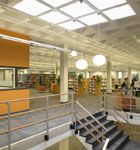 In northern Wisconsin there’s a library on the campus of Northland College that hasn’t turned on its furnace in three snowy winters. Dexter Library was formerly an un-insulated concrete-block building, typical of structures built in the early 1970s when energy and construction costs were cheap. After an extensive renovation in 2008, Dexter Library is now a LEED Gold building that serves as a gathering spot for a student body focused on sustainability. Dr. Michael A. Miller, president of the 600-student liberal arts college, and Jeffrey Scherer, FAIA, principal of Minneapolis architecture firm MS&R, discussed with gb&d how the renovation represents the college’s greater mission.
In northern Wisconsin there’s a library on the campus of Northland College that hasn’t turned on its furnace in three snowy winters. Dexter Library was formerly an un-insulated concrete-block building, typical of structures built in the early 1970s when energy and construction costs were cheap. After an extensive renovation in 2008, Dexter Library is now a LEED Gold building that serves as a gathering spot for a student body focused on sustainability. Dr. Michael A. Miller, president of the 600-student liberal arts college, and Jeffrey Scherer, FAIA, principal of Minneapolis architecture firm MS&R, discussed with gb&d how the renovation represents the college’s greater mission.
What was the impetus for improving Dexter Library?
JS: It started as a way of rethinking how learning spaces needed to support a small college. We reprogrammed the building to move most of the books to compact shelving on the lower floor and to turn the upper floor into an intellectual and collaborative hub where students can engage and learn. These students have a consciousness about their environment and how buildings relate to the world.
Where does Northland College’s commitment to the environment come from?
MM: In 1892, the northern part of Wisconsin was clear-cut for the logging industry, and what was left behind was an impoverished, challenged area. Northland College was created to provide a future for the people left behind and [for] the Native American tribes of the area. Those are the reasons and rationale behind our commitment to the environment. Our formal environmental commitment was made in 1971, and the Sigurd Olson Environmental Institute opened in 1972, which works to educate the community about Great Lakes environmental issues. It became a bold statement that looking after the environment through academic programs is important. All students as part of their general-education program receive a minor in environmental sciences.
How are you able to keep the heaters off in the winter?
MM: We haven’t had the furnace on in three years, and it’s cold up here. Dexter Library is heated by 30 geothermal wells extending 230 feet into the Earth, producing plenty of heat and no carbon dioxide. We also used water reduction strategies with low-flow toilets, and there’s little rainwater runoff. Most of the materials were reused.
Norwegian window-maker H Windows has a manufacturing facility in Ashland. You used their windows on the Dexter Library project, right?
MM: H Windows are remarkable in their ability to seal out cold air.
JS: Our company first used H Windows in the early ’90s on a huge project in Philadelphia, and we learned how wonderful their product was. Interestingly enough, H Windows is literally eight blocks from the college.
What other environmental features does the library have?
JS: The library is equipped with a 14-kilowatt photovoltaic solar array on the roof to produce energy for the building. Forty-eight occupant light sensors save energy and reduce electricity bills by turning off lights when not in use.
Northland College earned a Gold STARS rating. Why was this credential important?
MM: Most colleges and universities believe that part of our role is to think about how we [can] move forward efficiently and how business could be greener. The STARS rating provides a professional benchmark, validation of what we are doing, and [a] rubric for moving forward. A Gold rating is remarkable. We received a Platinum rating for education and research, one of only two institutions in the country to receive Platinum. It helps us to hold ourselves on course with our own planning and innovations. We’re a small institution and have close relationships with our students. We live our values at every level.

